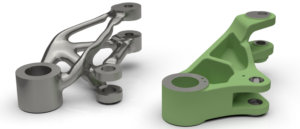Letting the computer generate designs from a designer’s directions may just be the future of design. Expect to see unorthodox, 3D-printed shapes all around in the not-to-distant future, as generative design can produce many valid designs rather than one, optimized version of an already-modeled part.
The design methods will describe the way engineers can use their software in a new way to the model that best fits design needs. The parts and shapes will be created in the real world via 3D printing methods—which can print any shape at all.
With those considerations in mind, Cimdata Inc., of Ann Arbor, Mich., a global PLM strategic management consulting and research firm, has released an ebook titled “Siemens PLM Software Advances Generative Design Technology in NX.”
This book looks at the technical approach adopted in NX, the flagship CAD solution of Siemens PLM Software.
Generative design is a process wherein the shape and composition of a product is determined by using physics-based simulation and other analysis methods that consider performance requirements and optimize objectives such as minimum cost and weight.
Topology optimization is the most familiar generative design process and its popularity is being driven by improvements in 3D printing. Such design approaches, however, challenge the traditional product development process in that many downstream tools do not understand the geometric output of topology optimization algorithms.

The Cimdata ebook introduces the concepts of generative design, specifically topology optimization. It includes a discussion of the generative design workflow and of overcoming the issue of importing the faceted geometry output of generative design algorithms into CAD using Siemens convergent modeling technology.
According to Peter Bilello, Cimdata’s president: “Given today’s rapidly advancing generative design and additive manufacturing technologies, a company must understand the impacts that their new workflows will have on their current design processes.”
Ken Versprille, Cimdata executive consultant, notes “CAD geometric modeling technology continues to evolve to support generative design methods. Siemens geometry technologists have demonstrated a long history of contributions to CAD modeling and are well positioned to support this new challenge.”
Generative design and topology optimization can bring design freedom and cost reduction to engineering and many types of design. Imagine a complex, oddly shaped part that is printed via additive manufacturing methods and performs as an assembly. That’s the promise of generative design and topology optimization.
Solid Edge, also from Siemens PLM Software, of Plano, Texas, also includes a generative design feature that brings topology optimization to the Solid Edge 3D product development toolkit, according to the company. With the feature, designers define a specific material, design space, permissible loads and constraints and a target weight, and the software automatically computes the geometric solution.
The results can be immediately manufactured on 3D printers, or further recreated as a Solid Edge model for traditional manufacturing. Designers can run multiple weight targets, load cases and constraint scenarios simultaneously, according to Siemens PLM.


Leave a Reply
You must be logged in to post a comment.